Strategic Information System Analysis and Proposal for ANZ Bank
VerifiedAdded on 2023/06/05
|17
|4431
|131
Report
AI Summary
This report delves into the strategic information system of ANZ Bank, a leading banking company in Australia, identifying critical success factors such as financial performance and strategic clarity. It evaluates ANZ's objectives, including fairness, simplicity in banking, and sustainable growth, using information from corporate sustainability reports and banking practice codes. The report includes an organizational chart, analyzes the bank's current CRM system, and highlights its weaknesses. To enhance effectiveness, an Accounting Information System is proposed, detailing its features for managing financial data and supporting decision-making. This comprehensive analysis aims to provide insights into improving ANZ Bank's strategic information infrastructure and competitive advantage, with a focus on integrating various business units and processes for optimal performance.
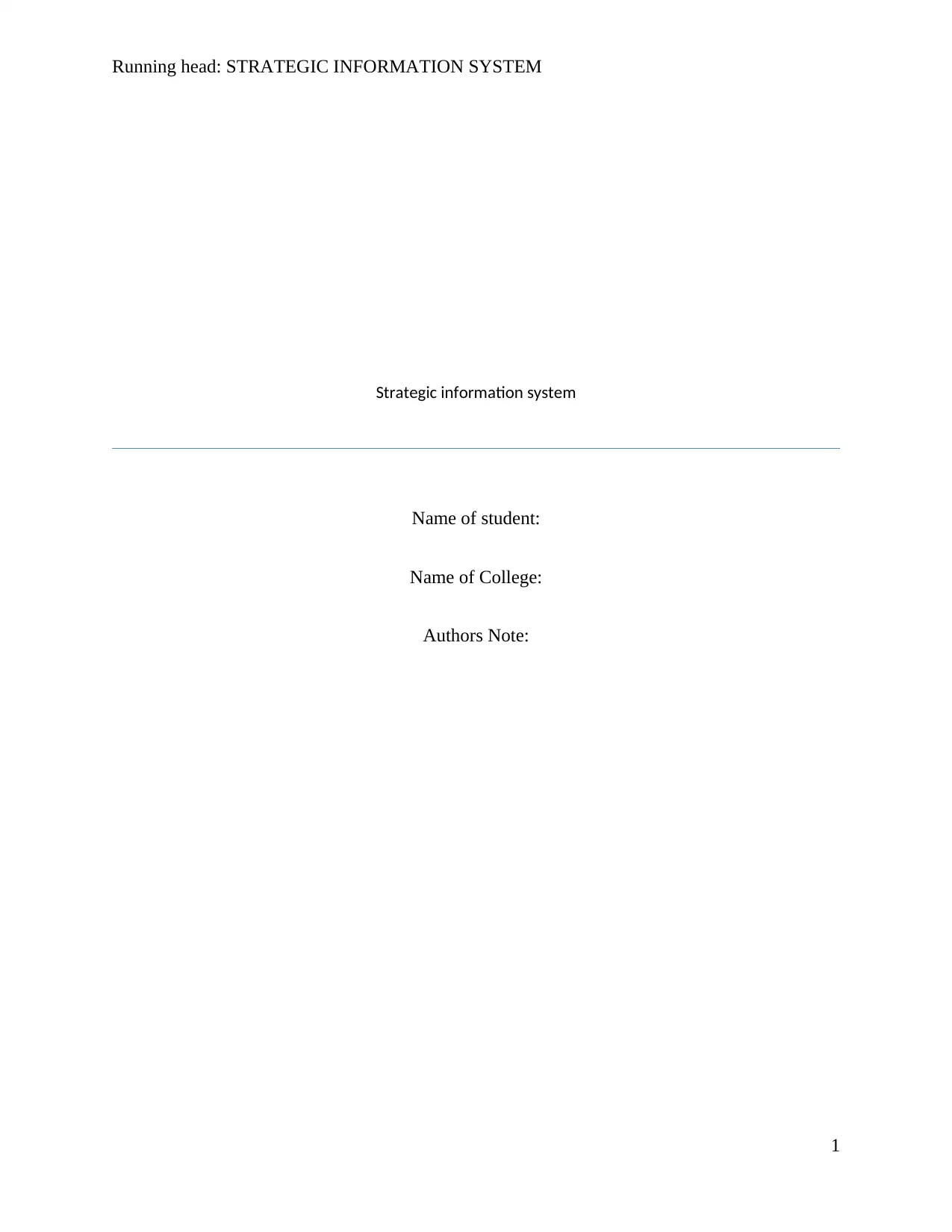
Running head: STRATEGIC INFORMATION SYSTEM
Strategic information system
Name of student:
Name of College:
Authors Note:
1
Strategic information system
Name of student:
Name of College:
Authors Note:
1
Paraphrase This Document
Need a fresh take? Get an instant paraphrase of this document with our AI Paraphraser
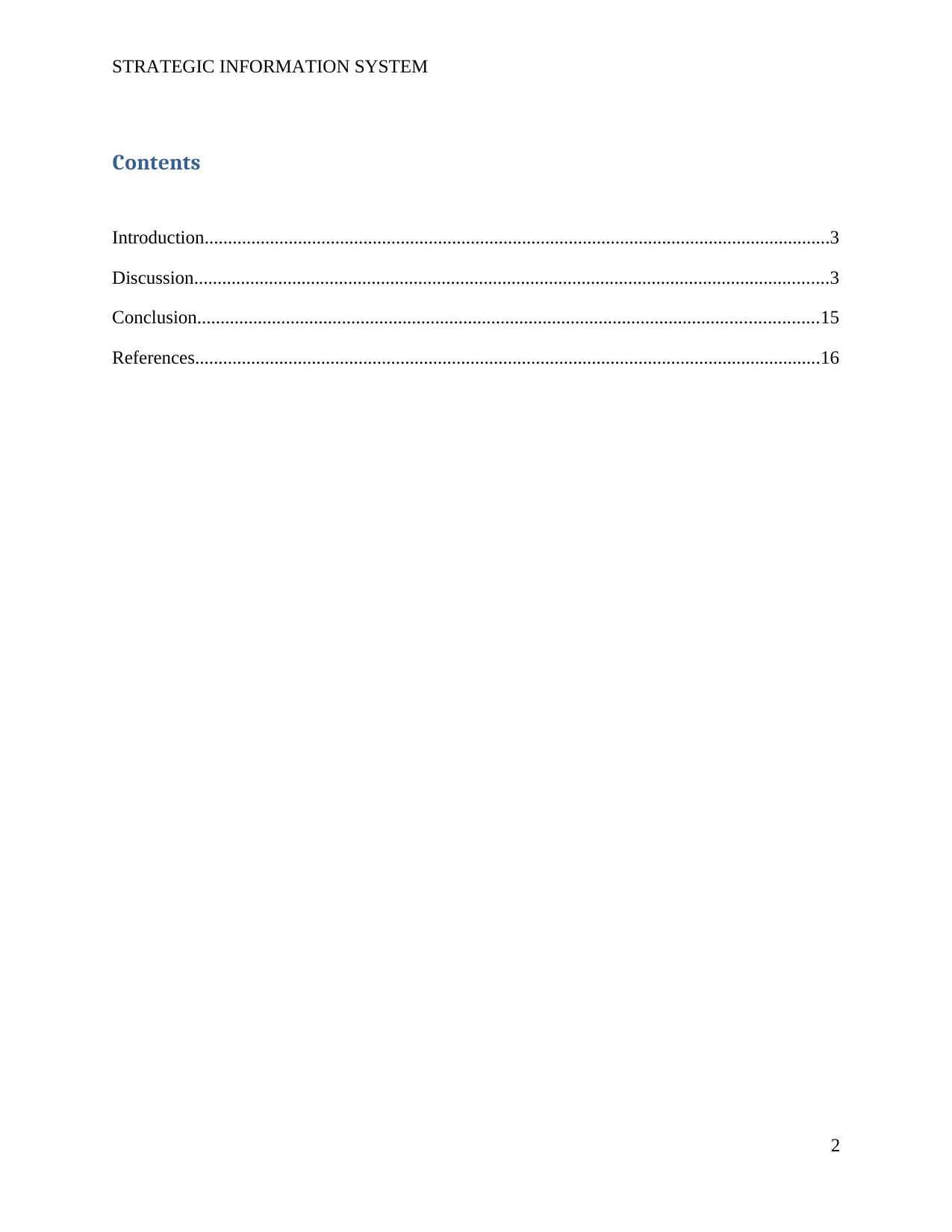
STRATEGIC INFORMATION SYSTEM
Contents
Introduction......................................................................................................................................3
Discussion........................................................................................................................................3
Conclusion.....................................................................................................................................15
References......................................................................................................................................16
2
Contents
Introduction......................................................................................................................................3
Discussion........................................................................................................................................3
Conclusion.....................................................................................................................................15
References......................................................................................................................................16
2
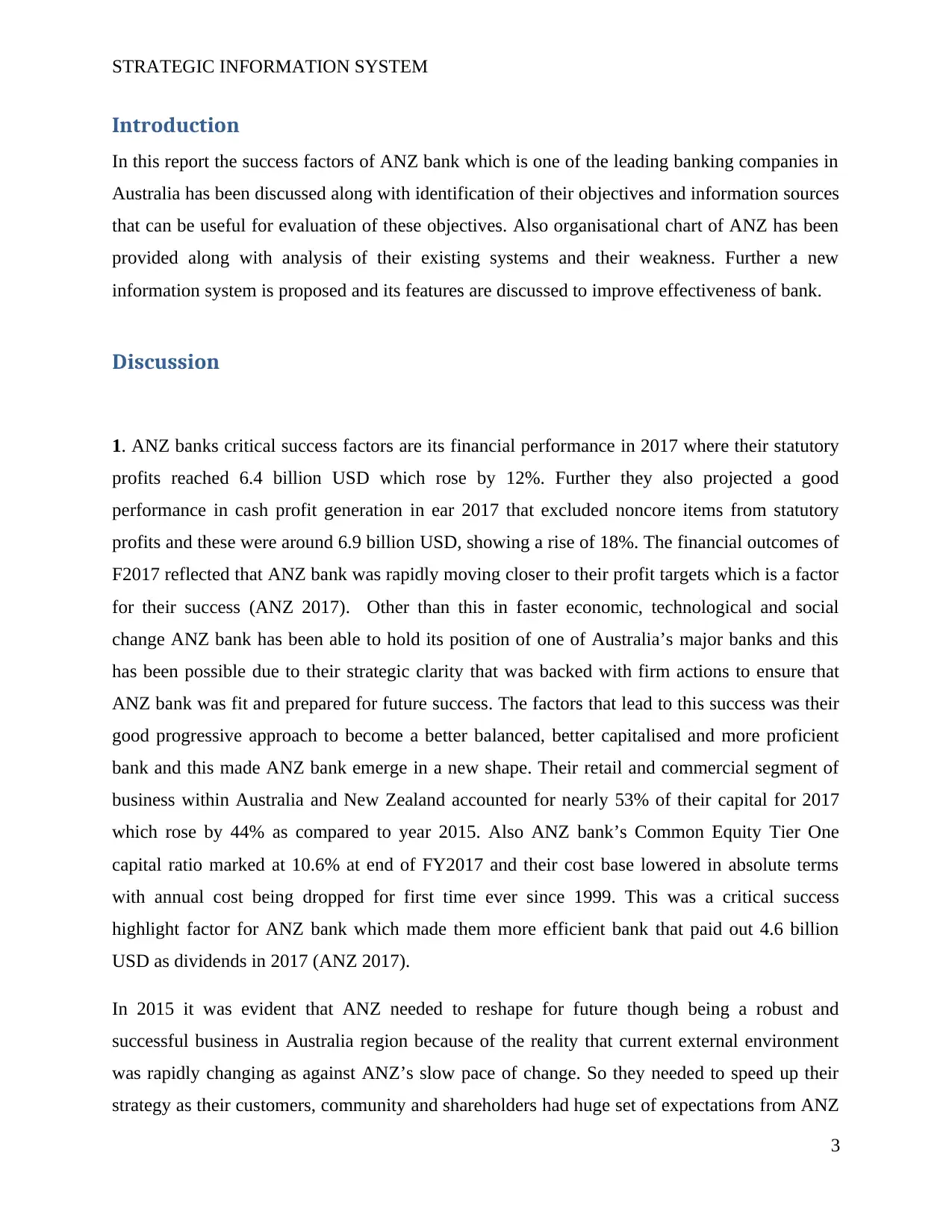
STRATEGIC INFORMATION SYSTEM
Introduction
In this report the success factors of ANZ bank which is one of the leading banking companies in
Australia has been discussed along with identification of their objectives and information sources
that can be useful for evaluation of these objectives. Also organisational chart of ANZ has been
provided along with analysis of their existing systems and their weakness. Further a new
information system is proposed and its features are discussed to improve effectiveness of bank.
Discussion
1. ANZ banks critical success factors are its financial performance in 2017 where their statutory
profits reached 6.4 billion USD which rose by 12%. Further they also projected a good
performance in cash profit generation in ear 2017 that excluded noncore items from statutory
profits and these were around 6.9 billion USD, showing a rise of 18%. The financial outcomes of
F2017 reflected that ANZ bank was rapidly moving closer to their profit targets which is a factor
for their success (ANZ 2017). Other than this in faster economic, technological and social
change ANZ bank has been able to hold its position of one of Australia’s major banks and this
has been possible due to their strategic clarity that was backed with firm actions to ensure that
ANZ bank was fit and prepared for future success. The factors that lead to this success was their
good progressive approach to become a better balanced, better capitalised and more proficient
bank and this made ANZ bank emerge in a new shape. Their retail and commercial segment of
business within Australia and New Zealand accounted for nearly 53% of their capital for 2017
which rose by 44% as compared to year 2015. Also ANZ bank’s Common Equity Tier One
capital ratio marked at 10.6% at end of FY2017 and their cost base lowered in absolute terms
with annual cost being dropped for first time ever since 1999. This was a critical success
highlight factor for ANZ bank which made them more efficient bank that paid out 4.6 billion
USD as dividends in 2017 (ANZ 2017).
In 2015 it was evident that ANZ needed to reshape for future though being a robust and
successful business in Australia region because of the reality that current external environment
was rapidly changing as against ANZ’s slow pace of change. So they needed to speed up their
strategy as their customers, community and shareholders had huge set of expectations from ANZ
3
Introduction
In this report the success factors of ANZ bank which is one of the leading banking companies in
Australia has been discussed along with identification of their objectives and information sources
that can be useful for evaluation of these objectives. Also organisational chart of ANZ has been
provided along with analysis of their existing systems and their weakness. Further a new
information system is proposed and its features are discussed to improve effectiveness of bank.
Discussion
1. ANZ banks critical success factors are its financial performance in 2017 where their statutory
profits reached 6.4 billion USD which rose by 12%. Further they also projected a good
performance in cash profit generation in ear 2017 that excluded noncore items from statutory
profits and these were around 6.9 billion USD, showing a rise of 18%. The financial outcomes of
F2017 reflected that ANZ bank was rapidly moving closer to their profit targets which is a factor
for their success (ANZ 2017). Other than this in faster economic, technological and social
change ANZ bank has been able to hold its position of one of Australia’s major banks and this
has been possible due to their strategic clarity that was backed with firm actions to ensure that
ANZ bank was fit and prepared for future success. The factors that lead to this success was their
good progressive approach to become a better balanced, better capitalised and more proficient
bank and this made ANZ bank emerge in a new shape. Their retail and commercial segment of
business within Australia and New Zealand accounted for nearly 53% of their capital for 2017
which rose by 44% as compared to year 2015. Also ANZ bank’s Common Equity Tier One
capital ratio marked at 10.6% at end of FY2017 and their cost base lowered in absolute terms
with annual cost being dropped for first time ever since 1999. This was a critical success
highlight factor for ANZ bank which made them more efficient bank that paid out 4.6 billion
USD as dividends in 2017 (ANZ 2017).
In 2015 it was evident that ANZ needed to reshape for future though being a robust and
successful business in Australia region because of the reality that current external environment
was rapidly changing as against ANZ’s slow pace of change. So they needed to speed up their
strategy as their customers, community and shareholders had huge set of expectations from ANZ
3
⊘ This is a preview!⊘
Do you want full access?
Subscribe today to unlock all pages.

Trusted by 1+ million students worldwide
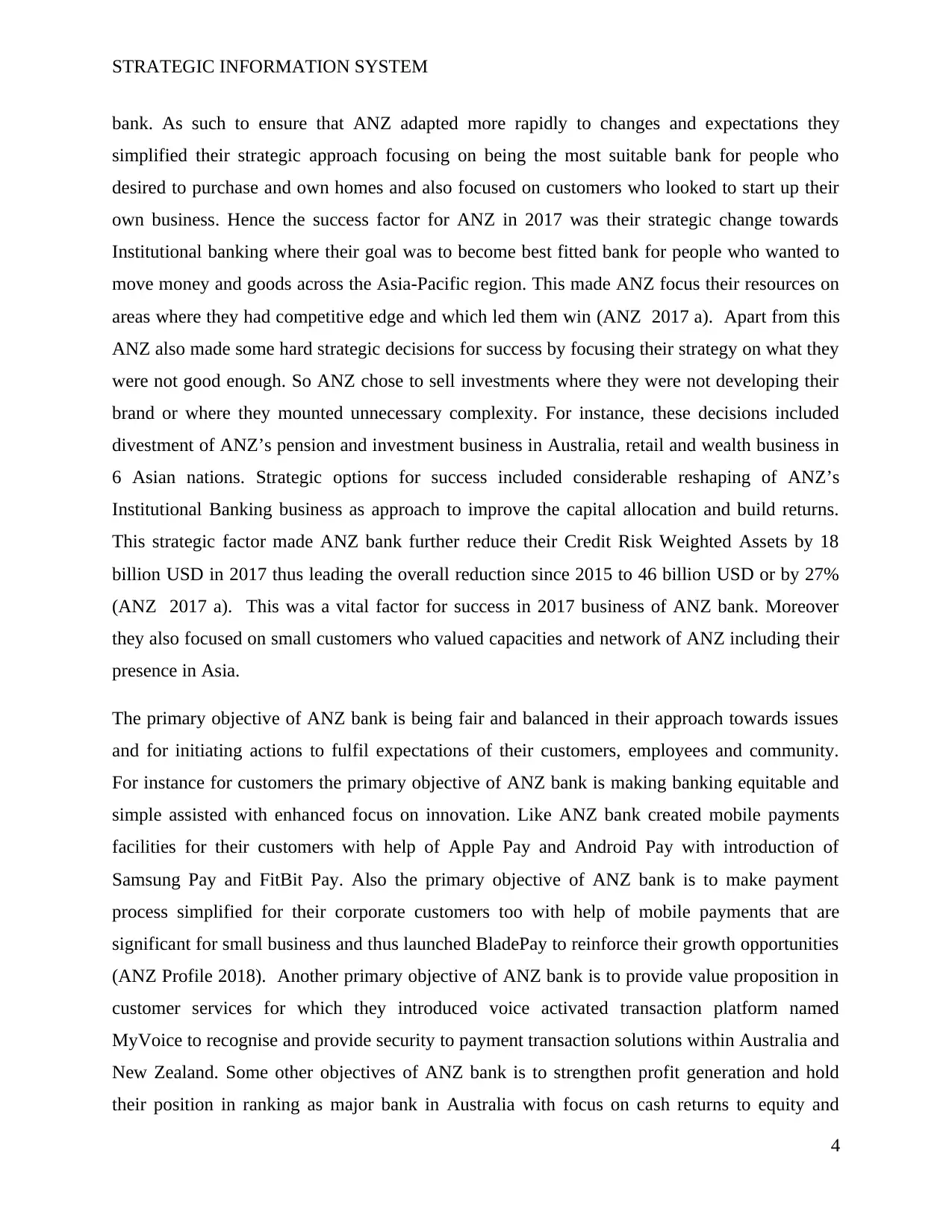
STRATEGIC INFORMATION SYSTEM
bank. As such to ensure that ANZ adapted more rapidly to changes and expectations they
simplified their strategic approach focusing on being the most suitable bank for people who
desired to purchase and own homes and also focused on customers who looked to start up their
own business. Hence the success factor for ANZ in 2017 was their strategic change towards
Institutional banking where their goal was to become best fitted bank for people who wanted to
move money and goods across the Asia-Pacific region. This made ANZ focus their resources on
areas where they had competitive edge and which led them win (ANZ 2017 a). Apart from this
ANZ also made some hard strategic decisions for success by focusing their strategy on what they
were not good enough. So ANZ chose to sell investments where they were not developing their
brand or where they mounted unnecessary complexity. For instance, these decisions included
divestment of ANZ’s pension and investment business in Australia, retail and wealth business in
6 Asian nations. Strategic options for success included considerable reshaping of ANZ’s
Institutional Banking business as approach to improve the capital allocation and build returns.
This strategic factor made ANZ bank further reduce their Credit Risk Weighted Assets by 18
billion USD in 2017 thus leading the overall reduction since 2015 to 46 billion USD or by 27%
(ANZ 2017 a). This was a vital factor for success in 2017 business of ANZ bank. Moreover
they also focused on small customers who valued capacities and network of ANZ including their
presence in Asia.
The primary objective of ANZ bank is being fair and balanced in their approach towards issues
and for initiating actions to fulfil expectations of their customers, employees and community.
For instance for customers the primary objective of ANZ bank is making banking equitable and
simple assisted with enhanced focus on innovation. Like ANZ bank created mobile payments
facilities for their customers with help of Apple Pay and Android Pay with introduction of
Samsung Pay and FitBit Pay. Also the primary objective of ANZ bank is to make payment
process simplified for their corporate customers too with help of mobile payments that are
significant for small business and thus launched BladePay to reinforce their growth opportunities
(ANZ Profile 2018). Another primary objective of ANZ bank is to provide value proposition in
customer services for which they introduced voice activated transaction platform named
MyVoice to recognise and provide security to payment transaction solutions within Australia and
New Zealand. Some other objectives of ANZ bank is to strengthen profit generation and hold
their position in ranking as major bank in Australia with focus on cash returns to equity and
4
bank. As such to ensure that ANZ adapted more rapidly to changes and expectations they
simplified their strategic approach focusing on being the most suitable bank for people who
desired to purchase and own homes and also focused on customers who looked to start up their
own business. Hence the success factor for ANZ in 2017 was their strategic change towards
Institutional banking where their goal was to become best fitted bank for people who wanted to
move money and goods across the Asia-Pacific region. This made ANZ focus their resources on
areas where they had competitive edge and which led them win (ANZ 2017 a). Apart from this
ANZ also made some hard strategic decisions for success by focusing their strategy on what they
were not good enough. So ANZ chose to sell investments where they were not developing their
brand or where they mounted unnecessary complexity. For instance, these decisions included
divestment of ANZ’s pension and investment business in Australia, retail and wealth business in
6 Asian nations. Strategic options for success included considerable reshaping of ANZ’s
Institutional Banking business as approach to improve the capital allocation and build returns.
This strategic factor made ANZ bank further reduce their Credit Risk Weighted Assets by 18
billion USD in 2017 thus leading the overall reduction since 2015 to 46 billion USD or by 27%
(ANZ 2017 a). This was a vital factor for success in 2017 business of ANZ bank. Moreover
they also focused on small customers who valued capacities and network of ANZ including their
presence in Asia.
The primary objective of ANZ bank is being fair and balanced in their approach towards issues
and for initiating actions to fulfil expectations of their customers, employees and community.
For instance for customers the primary objective of ANZ bank is making banking equitable and
simple assisted with enhanced focus on innovation. Like ANZ bank created mobile payments
facilities for their customers with help of Apple Pay and Android Pay with introduction of
Samsung Pay and FitBit Pay. Also the primary objective of ANZ bank is to make payment
process simplified for their corporate customers too with help of mobile payments that are
significant for small business and thus launched BladePay to reinforce their growth opportunities
(ANZ Profile 2018). Another primary objective of ANZ bank is to provide value proposition in
customer services for which they introduced voice activated transaction platform named
MyVoice to recognise and provide security to payment transaction solutions within Australia and
New Zealand. Some other objectives of ANZ bank is to strengthen profit generation and hold
their position in ranking as major bank in Australia with focus on cash returns to equity and
4
Paraphrase This Document
Need a fresh take? Get an instant paraphrase of this document with our AI Paraphraser
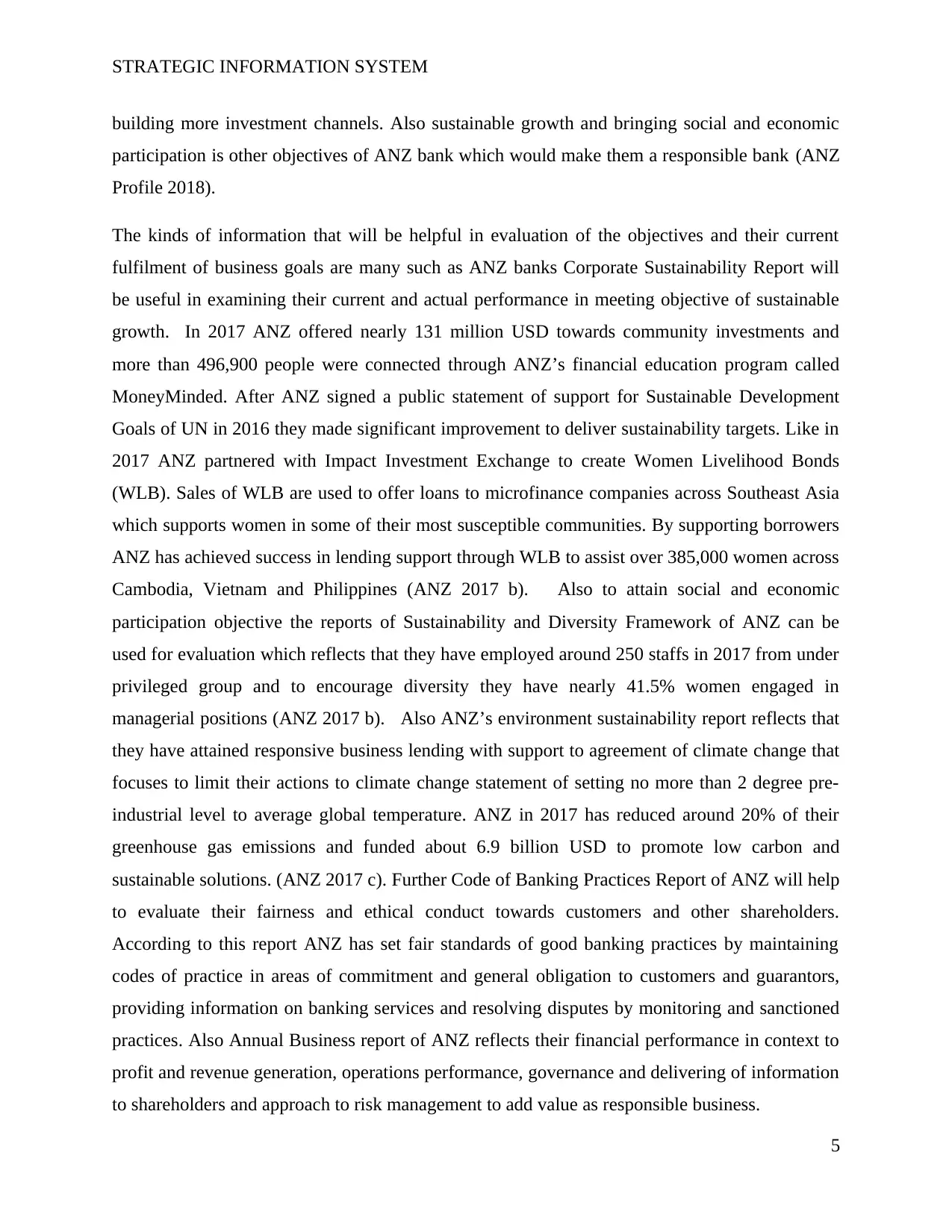
STRATEGIC INFORMATION SYSTEM
building more investment channels. Also sustainable growth and bringing social and economic
participation is other objectives of ANZ bank which would make them a responsible bank (ANZ
Profile 2018).
The kinds of information that will be helpful in evaluation of the objectives and their current
fulfilment of business goals are many such as ANZ banks Corporate Sustainability Report will
be useful in examining their current and actual performance in meeting objective of sustainable
growth. In 2017 ANZ offered nearly 131 million USD towards community investments and
more than 496,900 people were connected through ANZ’s financial education program called
MoneyMinded. After ANZ signed a public statement of support for Sustainable Development
Goals of UN in 2016 they made significant improvement to deliver sustainability targets. Like in
2017 ANZ partnered with Impact Investment Exchange to create Women Livelihood Bonds
(WLB). Sales of WLB are used to offer loans to microfinance companies across Southeast Asia
which supports women in some of their most susceptible communities. By supporting borrowers
ANZ has achieved success in lending support through WLB to assist over 385,000 women across
Cambodia, Vietnam and Philippines (ANZ 2017 b). Also to attain social and economic
participation objective the reports of Sustainability and Diversity Framework of ANZ can be
used for evaluation which reflects that they have employed around 250 staffs in 2017 from under
privileged group and to encourage diversity they have nearly 41.5% women engaged in
managerial positions (ANZ 2017 b). Also ANZ’s environment sustainability report reflects that
they have attained responsive business lending with support to agreement of climate change that
focuses to limit their actions to climate change statement of setting no more than 2 degree pre-
industrial level to average global temperature. ANZ in 2017 has reduced around 20% of their
greenhouse gas emissions and funded about 6.9 billion USD to promote low carbon and
sustainable solutions. (ANZ 2017 c). Further Code of Banking Practices Report of ANZ will help
to evaluate their fairness and ethical conduct towards customers and other shareholders.
According to this report ANZ has set fair standards of good banking practices by maintaining
codes of practice in areas of commitment and general obligation to customers and guarantors,
providing information on banking services and resolving disputes by monitoring and sanctioned
practices. Also Annual Business report of ANZ reflects their financial performance in context to
profit and revenue generation, operations performance, governance and delivering of information
to shareholders and approach to risk management to add value as responsible business.
5
building more investment channels. Also sustainable growth and bringing social and economic
participation is other objectives of ANZ bank which would make them a responsible bank (ANZ
Profile 2018).
The kinds of information that will be helpful in evaluation of the objectives and their current
fulfilment of business goals are many such as ANZ banks Corporate Sustainability Report will
be useful in examining their current and actual performance in meeting objective of sustainable
growth. In 2017 ANZ offered nearly 131 million USD towards community investments and
more than 496,900 people were connected through ANZ’s financial education program called
MoneyMinded. After ANZ signed a public statement of support for Sustainable Development
Goals of UN in 2016 they made significant improvement to deliver sustainability targets. Like in
2017 ANZ partnered with Impact Investment Exchange to create Women Livelihood Bonds
(WLB). Sales of WLB are used to offer loans to microfinance companies across Southeast Asia
which supports women in some of their most susceptible communities. By supporting borrowers
ANZ has achieved success in lending support through WLB to assist over 385,000 women across
Cambodia, Vietnam and Philippines (ANZ 2017 b). Also to attain social and economic
participation objective the reports of Sustainability and Diversity Framework of ANZ can be
used for evaluation which reflects that they have employed around 250 staffs in 2017 from under
privileged group and to encourage diversity they have nearly 41.5% women engaged in
managerial positions (ANZ 2017 b). Also ANZ’s environment sustainability report reflects that
they have attained responsive business lending with support to agreement of climate change that
focuses to limit their actions to climate change statement of setting no more than 2 degree pre-
industrial level to average global temperature. ANZ in 2017 has reduced around 20% of their
greenhouse gas emissions and funded about 6.9 billion USD to promote low carbon and
sustainable solutions. (ANZ 2017 c). Further Code of Banking Practices Report of ANZ will help
to evaluate their fairness and ethical conduct towards customers and other shareholders.
According to this report ANZ has set fair standards of good banking practices by maintaining
codes of practice in areas of commitment and general obligation to customers and guarantors,
providing information on banking services and resolving disputes by monitoring and sanctioned
practices. Also Annual Business report of ANZ reflects their financial performance in context to
profit and revenue generation, operations performance, governance and delivering of information
to shareholders and approach to risk management to add value as responsible business.
5
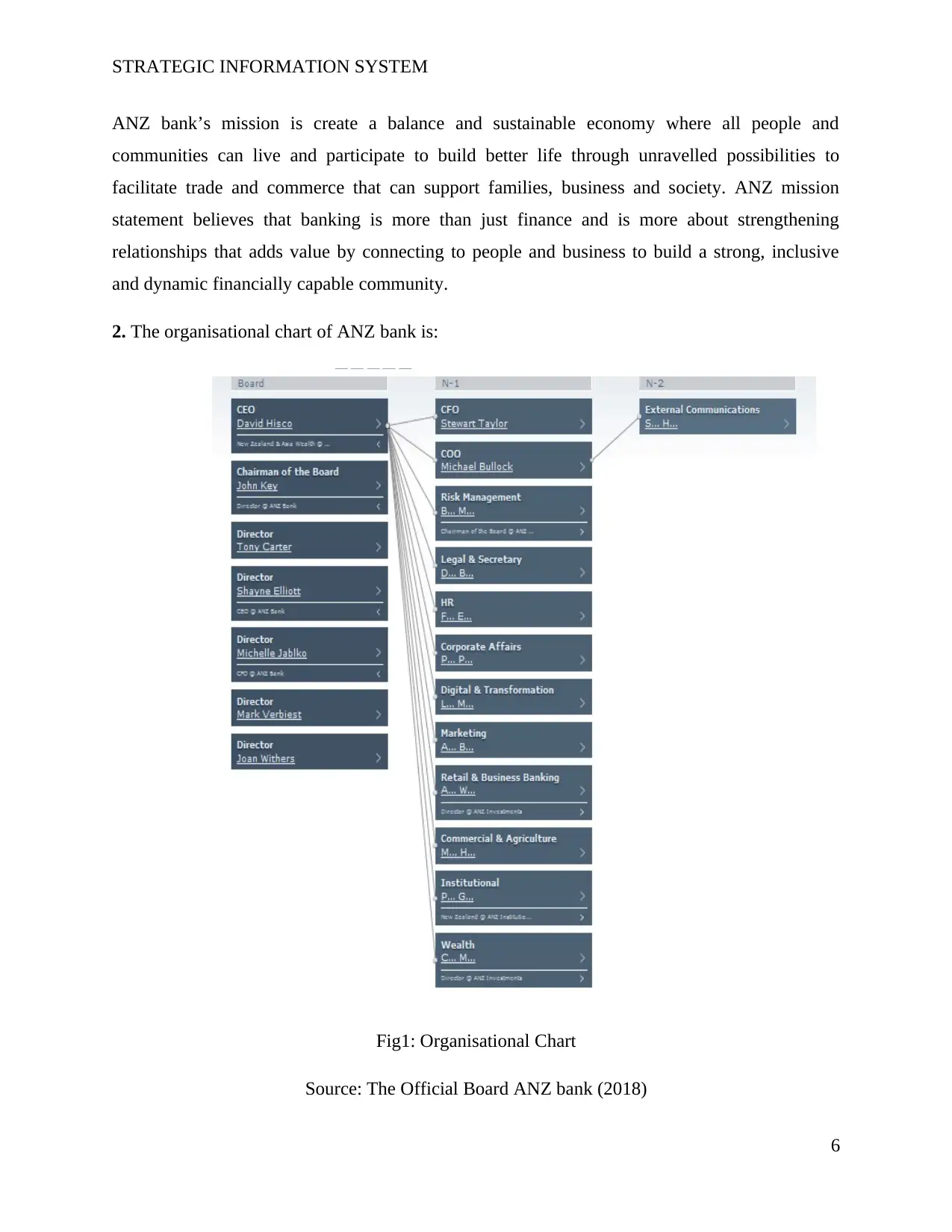
STRATEGIC INFORMATION SYSTEM
ANZ bank’s mission is create a balance and sustainable economy where all people and
communities can live and participate to build better life through unravelled possibilities to
facilitate trade and commerce that can support families, business and society. ANZ mission
statement believes that banking is more than just finance and is more about strengthening
relationships that adds value by connecting to people and business to build a strong, inclusive
and dynamic financially capable community.
2. The organisational chart of ANZ bank is:
Fig1: Organisational Chart
Source: The Official Board ANZ bank (2018)
6
ANZ bank’s mission is create a balance and sustainable economy where all people and
communities can live and participate to build better life through unravelled possibilities to
facilitate trade and commerce that can support families, business and society. ANZ mission
statement believes that banking is more than just finance and is more about strengthening
relationships that adds value by connecting to people and business to build a strong, inclusive
and dynamic financially capable community.
2. The organisational chart of ANZ bank is:
Fig1: Organisational Chart
Source: The Official Board ANZ bank (2018)
6
⊘ This is a preview!⊘
Do you want full access?
Subscribe today to unlock all pages.

Trusted by 1+ million students worldwide
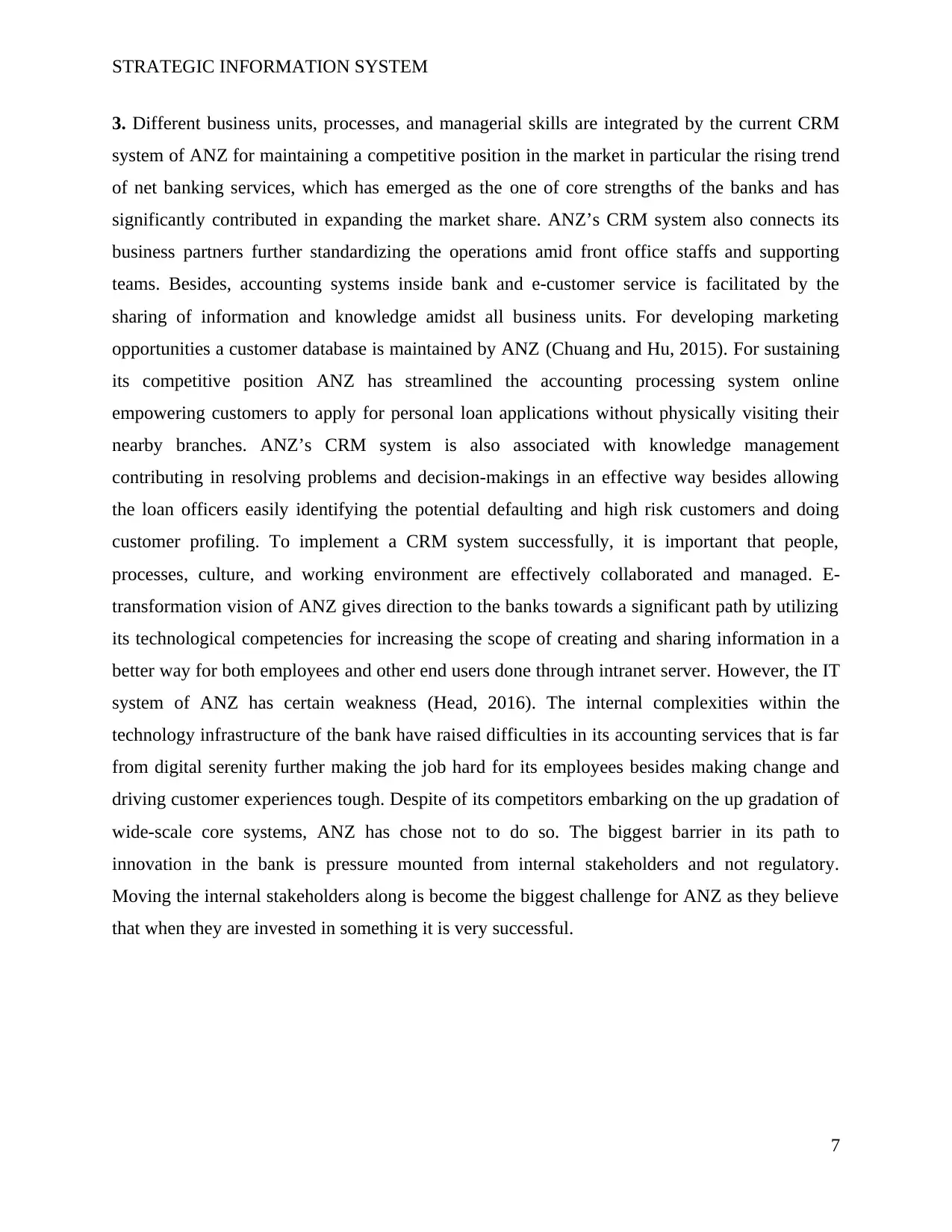
STRATEGIC INFORMATION SYSTEM
3. Different business units, processes, and managerial skills are integrated by the current CRM
system of ANZ for maintaining a competitive position in the market in particular the rising trend
of net banking services, which has emerged as the one of core strengths of the banks and has
significantly contributed in expanding the market share. ANZ’s CRM system also connects its
business partners further standardizing the operations amid front office staffs and supporting
teams. Besides, accounting systems inside bank and e-customer service is facilitated by the
sharing of information and knowledge amidst all business units. For developing marketing
opportunities a customer database is maintained by ANZ (Chuang and Hu, 2015). For sustaining
its competitive position ANZ has streamlined the accounting processing system online
empowering customers to apply for personal loan applications without physically visiting their
nearby branches. ANZ’s CRM system is also associated with knowledge management
contributing in resolving problems and decision-makings in an effective way besides allowing
the loan officers easily identifying the potential defaulting and high risk customers and doing
customer profiling. To implement a CRM system successfully, it is important that people,
processes, culture, and working environment are effectively collaborated and managed. E-
transformation vision of ANZ gives direction to the banks towards a significant path by utilizing
its technological competencies for increasing the scope of creating and sharing information in a
better way for both employees and other end users done through intranet server. However, the IT
system of ANZ has certain weakness (Head, 2016). The internal complexities within the
technology infrastructure of the bank have raised difficulties in its accounting services that is far
from digital serenity further making the job hard for its employees besides making change and
driving customer experiences tough. Despite of its competitors embarking on the up gradation of
wide-scale core systems, ANZ has chose not to do so. The biggest barrier in its path to
innovation in the bank is pressure mounted from internal stakeholders and not regulatory.
Moving the internal stakeholders along is become the biggest challenge for ANZ as they believe
that when they are invested in something it is very successful.
7
3. Different business units, processes, and managerial skills are integrated by the current CRM
system of ANZ for maintaining a competitive position in the market in particular the rising trend
of net banking services, which has emerged as the one of core strengths of the banks and has
significantly contributed in expanding the market share. ANZ’s CRM system also connects its
business partners further standardizing the operations amid front office staffs and supporting
teams. Besides, accounting systems inside bank and e-customer service is facilitated by the
sharing of information and knowledge amidst all business units. For developing marketing
opportunities a customer database is maintained by ANZ (Chuang and Hu, 2015). For sustaining
its competitive position ANZ has streamlined the accounting processing system online
empowering customers to apply for personal loan applications without physically visiting their
nearby branches. ANZ’s CRM system is also associated with knowledge management
contributing in resolving problems and decision-makings in an effective way besides allowing
the loan officers easily identifying the potential defaulting and high risk customers and doing
customer profiling. To implement a CRM system successfully, it is important that people,
processes, culture, and working environment are effectively collaborated and managed. E-
transformation vision of ANZ gives direction to the banks towards a significant path by utilizing
its technological competencies for increasing the scope of creating and sharing information in a
better way for both employees and other end users done through intranet server. However, the IT
system of ANZ has certain weakness (Head, 2016). The internal complexities within the
technology infrastructure of the bank have raised difficulties in its accounting services that is far
from digital serenity further making the job hard for its employees besides making change and
driving customer experiences tough. Despite of its competitors embarking on the up gradation of
wide-scale core systems, ANZ has chose not to do so. The biggest barrier in its path to
innovation in the bank is pressure mounted from internal stakeholders and not regulatory.
Moving the internal stakeholders along is become the biggest challenge for ANZ as they believe
that when they are invested in something it is very successful.
7
Paraphrase This Document
Need a fresh take? Get an instant paraphrase of this document with our AI Paraphraser
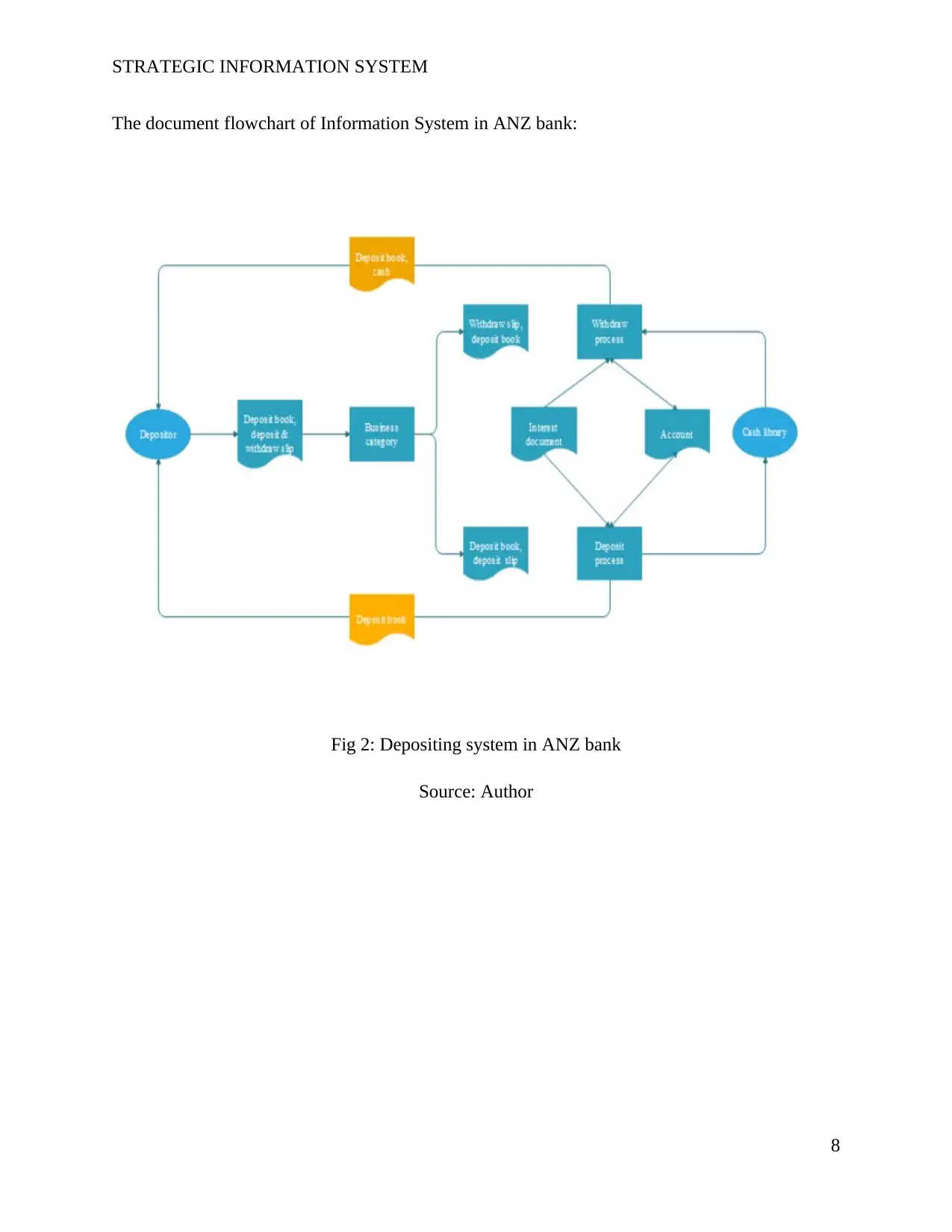
STRATEGIC INFORMATION SYSTEM
The document flowchart of Information System in ANZ bank:
Fig 2: Depositing system in ANZ bank
Source: Author
8
The document flowchart of Information System in ANZ bank:
Fig 2: Depositing system in ANZ bank
Source: Author
8
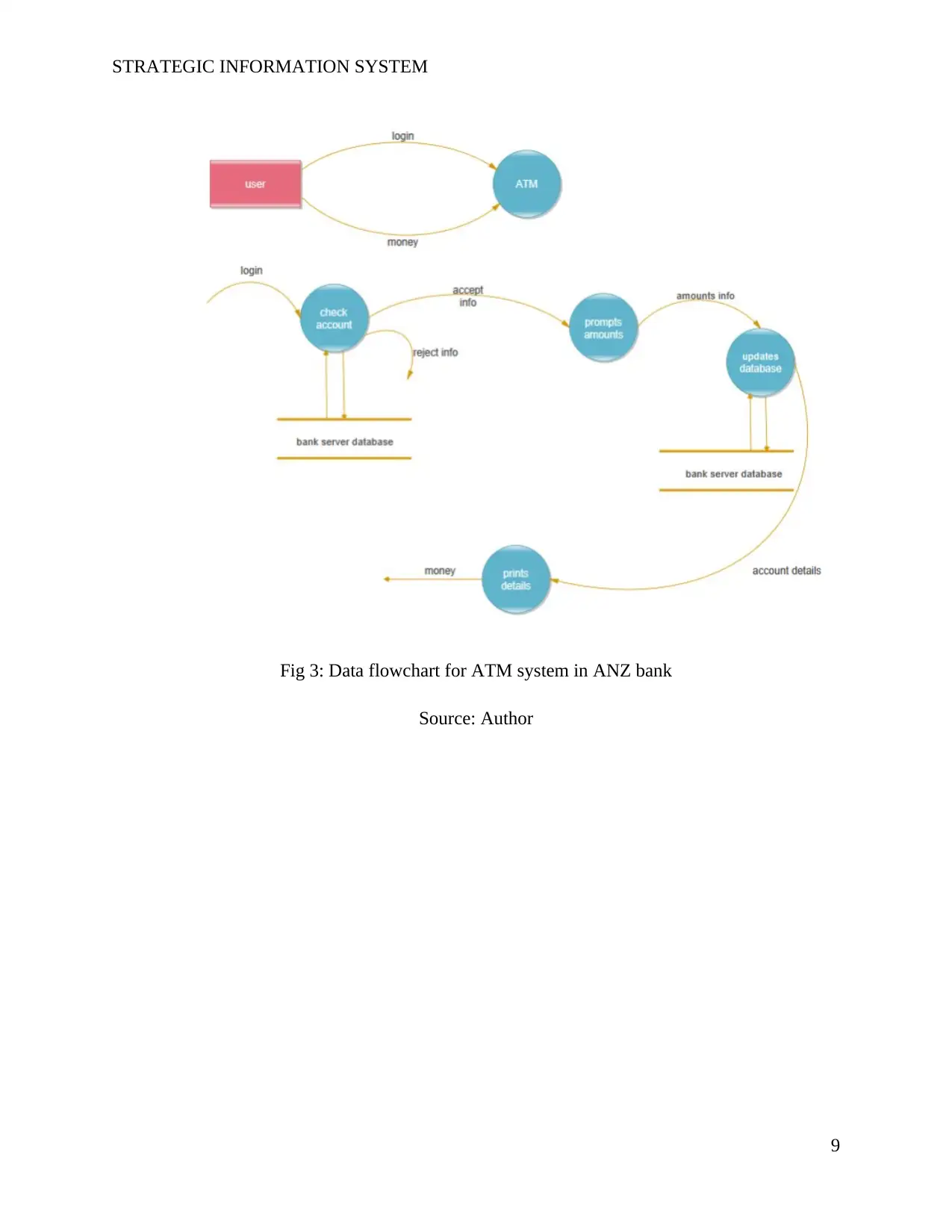
STRATEGIC INFORMATION SYSTEM
Fig 3: Data flowchart for ATM system in ANZ bank
Source: Author
9
Fig 3: Data flowchart for ATM system in ANZ bank
Source: Author
9
⊘ This is a preview!⊘
Do you want full access?
Subscribe today to unlock all pages.

Trusted by 1+ million students worldwide
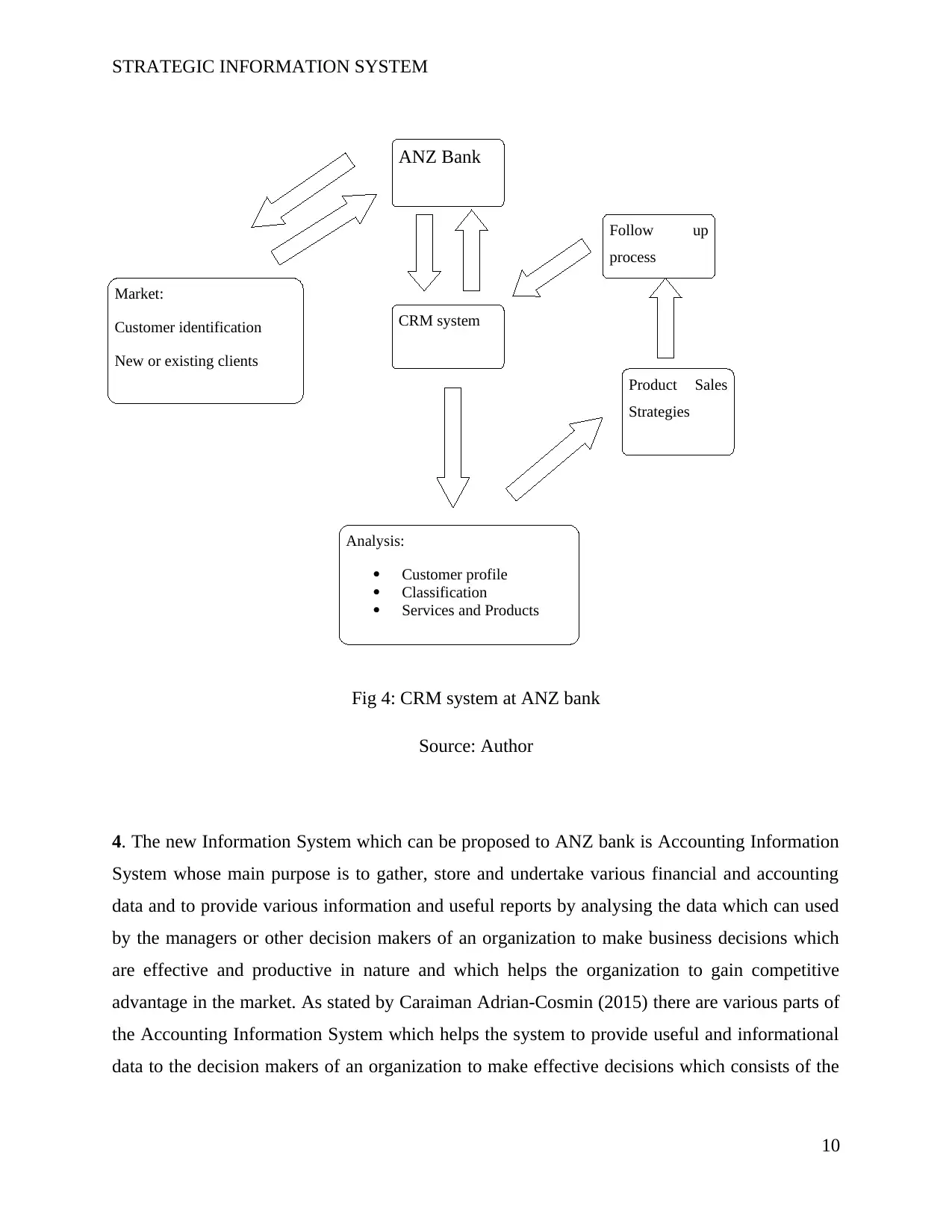
STRATEGIC INFORMATION SYSTEM
Fig 4: CRM system at ANZ bank
Source: Author
4. The new Information System which can be proposed to ANZ bank is Accounting Information
System whose main purpose is to gather, store and undertake various financial and accounting
data and to provide various information and useful reports by analysing the data which can used
by the managers or other decision makers of an organization to make business decisions which
are effective and productive in nature and which helps the organization to gain competitive
advantage in the market. As stated by Caraiman Adrian-Cosmin (2015) there are various parts of
the Accounting Information System which helps the system to provide useful and informational
data to the decision makers of an organization to make effective decisions which consists of the
10
ANZ Bank
CRM system
Follow up
process
Product Sales
Strategies
Analysis:
Customer profile
Classification
Services and Products
Market:
Customer identification
New or existing clients
Fig 4: CRM system at ANZ bank
Source: Author
4. The new Information System which can be proposed to ANZ bank is Accounting Information
System whose main purpose is to gather, store and undertake various financial and accounting
data and to provide various information and useful reports by analysing the data which can used
by the managers or other decision makers of an organization to make business decisions which
are effective and productive in nature and which helps the organization to gain competitive
advantage in the market. As stated by Caraiman Adrian-Cosmin (2015) there are various parts of
the Accounting Information System which helps the system to provide useful and informational
data to the decision makers of an organization to make effective decisions which consists of the
10
ANZ Bank
CRM system
Follow up
process
Product Sales
Strategies
Analysis:
Customer profile
Classification
Services and Products
Market:
Customer identification
New or existing clients
Paraphrase This Document
Need a fresh take? Get an instant paraphrase of this document with our AI Paraphraser
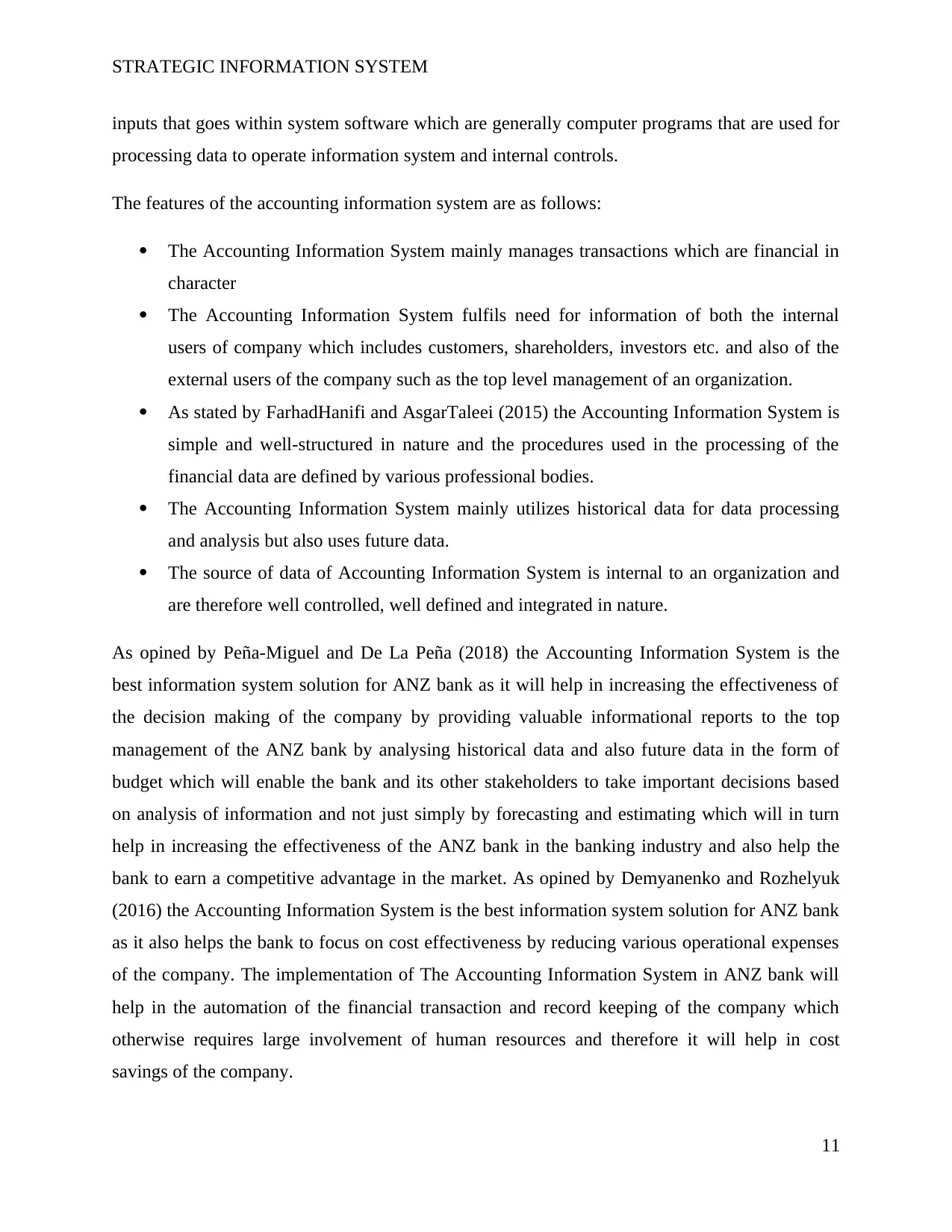
STRATEGIC INFORMATION SYSTEM
inputs that goes within system software which are generally computer programs that are used for
processing data to operate information system and internal controls.
The features of the accounting information system are as follows:
The Accounting Information System mainly manages transactions which are financial in
character
The Accounting Information System fulfils need for information of both the internal
users of company which includes customers, shareholders, investors etc. and also of the
external users of the company such as the top level management of an organization.
As stated by FarhadHanifi and AsgarTaleei (2015) the Accounting Information System is
simple and well-structured in nature and the procedures used in the processing of the
financial data are defined by various professional bodies.
The Accounting Information System mainly utilizes historical data for data processing
and analysis but also uses future data.
The source of data of Accounting Information System is internal to an organization and
are therefore well controlled, well defined and integrated in nature.
As opined by Peña-Miguel and De La Peña (2018) the Accounting Information System is the
best information system solution for ANZ bank as it will help in increasing the effectiveness of
the decision making of the company by providing valuable informational reports to the top
management of the ANZ bank by analysing historical data and also future data in the form of
budget which will enable the bank and its other stakeholders to take important decisions based
on analysis of information and not just simply by forecasting and estimating which will in turn
help in increasing the effectiveness of the ANZ bank in the banking industry and also help the
bank to earn a competitive advantage in the market. As opined by Demyanenko and Rozhelyuk
(2016) the Accounting Information System is the best information system solution for ANZ bank
as it also helps the bank to focus on cost effectiveness by reducing various operational expenses
of the company. The implementation of The Accounting Information System in ANZ bank will
help in the automation of the financial transaction and record keeping of the company which
otherwise requires large involvement of human resources and therefore it will help in cost
savings of the company.
11
inputs that goes within system software which are generally computer programs that are used for
processing data to operate information system and internal controls.
The features of the accounting information system are as follows:
The Accounting Information System mainly manages transactions which are financial in
character
The Accounting Information System fulfils need for information of both the internal
users of company which includes customers, shareholders, investors etc. and also of the
external users of the company such as the top level management of an organization.
As stated by FarhadHanifi and AsgarTaleei (2015) the Accounting Information System is
simple and well-structured in nature and the procedures used in the processing of the
financial data are defined by various professional bodies.
The Accounting Information System mainly utilizes historical data for data processing
and analysis but also uses future data.
The source of data of Accounting Information System is internal to an organization and
are therefore well controlled, well defined and integrated in nature.
As opined by Peña-Miguel and De La Peña (2018) the Accounting Information System is the
best information system solution for ANZ bank as it will help in increasing the effectiveness of
the decision making of the company by providing valuable informational reports to the top
management of the ANZ bank by analysing historical data and also future data in the form of
budget which will enable the bank and its other stakeholders to take important decisions based
on analysis of information and not just simply by forecasting and estimating which will in turn
help in increasing the effectiveness of the ANZ bank in the banking industry and also help the
bank to earn a competitive advantage in the market. As opined by Demyanenko and Rozhelyuk
(2016) the Accounting Information System is the best information system solution for ANZ bank
as it also helps the bank to focus on cost effectiveness by reducing various operational expenses
of the company. The implementation of The Accounting Information System in ANZ bank will
help in the automation of the financial transaction and record keeping of the company which
otherwise requires large involvement of human resources and therefore it will help in cost
savings of the company.
11
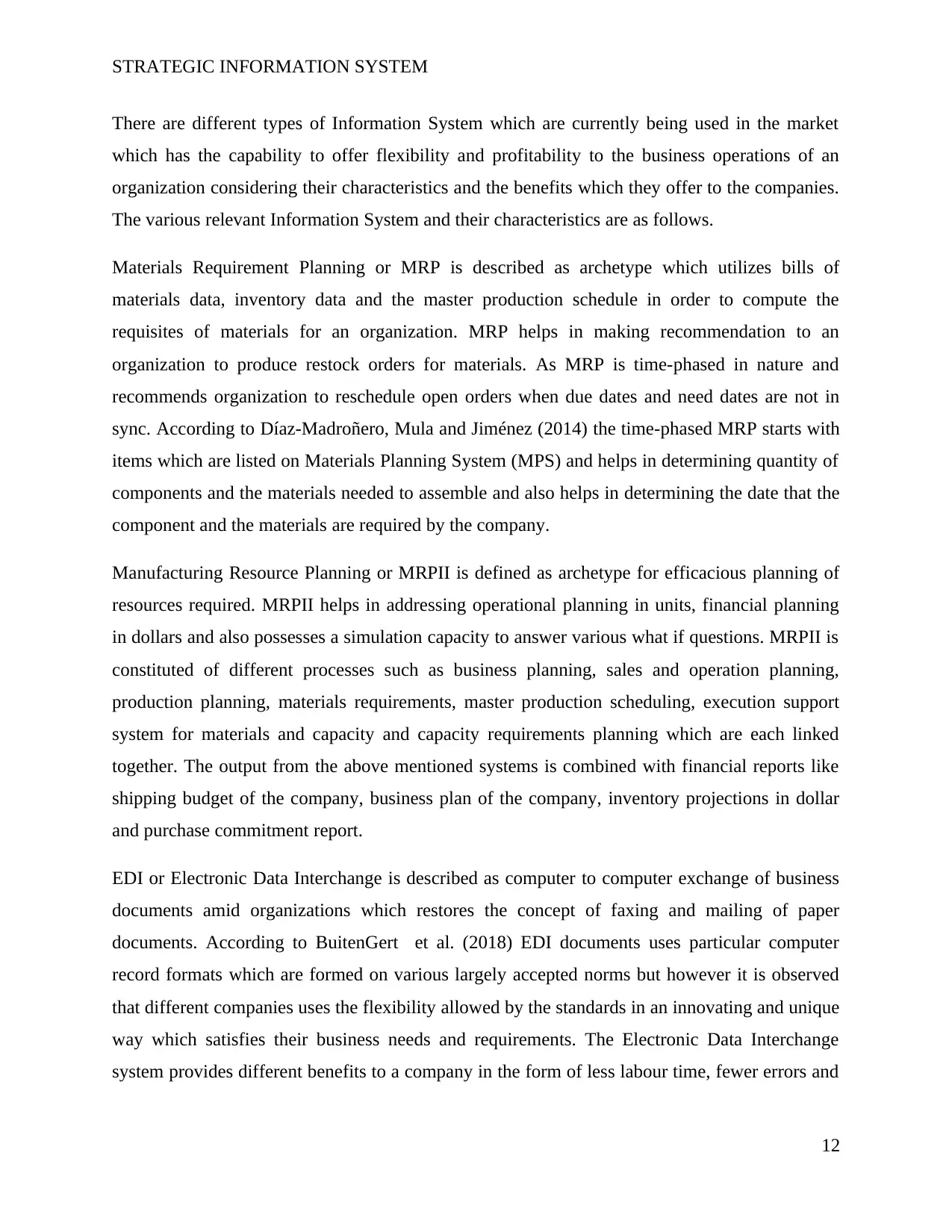
STRATEGIC INFORMATION SYSTEM
There are different types of Information System which are currently being used in the market
which has the capability to offer flexibility and profitability to the business operations of an
organization considering their characteristics and the benefits which they offer to the companies.
The various relevant Information System and their characteristics are as follows.
Materials Requirement Planning or MRP is described as archetype which utilizes bills of
materials data, inventory data and the master production schedule in order to compute the
requisites of materials for an organization. MRP helps in making recommendation to an
organization to produce restock orders for materials. As MRP is time-phased in nature and
recommends organization to reschedule open orders when due dates and need dates are not in
sync. According to Díaz-Madroñero, Mula and Jiménez (2014) the time-phased MRP starts with
items which are listed on Materials Planning System (MPS) and helps in determining quantity of
components and the materials needed to assemble and also helps in determining the date that the
component and the materials are required by the company.
Manufacturing Resource Planning or MRPII is defined as archetype for efficacious planning of
resources required. MRPII helps in addressing operational planning in units, financial planning
in dollars and also possesses a simulation capacity to answer various what if questions. MRPII is
constituted of different processes such as business planning, sales and operation planning,
production planning, materials requirements, master production scheduling, execution support
system for materials and capacity and capacity requirements planning which are each linked
together. The output from the above mentioned systems is combined with financial reports like
shipping budget of the company, business plan of the company, inventory projections in dollar
and purchase commitment report.
EDI or Electronic Data Interchange is described as computer to computer exchange of business
documents amid organizations which restores the concept of faxing and mailing of paper
documents. According to BuitenGert et al. (2018) EDI documents uses particular computer
record formats which are formed on various largely accepted norms but however it is observed
that different companies uses the flexibility allowed by the standards in an innovating and unique
way which satisfies their business needs and requirements. The Electronic Data Interchange
system provides different benefits to a company in the form of less labour time, fewer errors and
12
There are different types of Information System which are currently being used in the market
which has the capability to offer flexibility and profitability to the business operations of an
organization considering their characteristics and the benefits which they offer to the companies.
The various relevant Information System and their characteristics are as follows.
Materials Requirement Planning or MRP is described as archetype which utilizes bills of
materials data, inventory data and the master production schedule in order to compute the
requisites of materials for an organization. MRP helps in making recommendation to an
organization to produce restock orders for materials. As MRP is time-phased in nature and
recommends organization to reschedule open orders when due dates and need dates are not in
sync. According to Díaz-Madroñero, Mula and Jiménez (2014) the time-phased MRP starts with
items which are listed on Materials Planning System (MPS) and helps in determining quantity of
components and the materials needed to assemble and also helps in determining the date that the
component and the materials are required by the company.
Manufacturing Resource Planning or MRPII is defined as archetype for efficacious planning of
resources required. MRPII helps in addressing operational planning in units, financial planning
in dollars and also possesses a simulation capacity to answer various what if questions. MRPII is
constituted of different processes such as business planning, sales and operation planning,
production planning, materials requirements, master production scheduling, execution support
system for materials and capacity and capacity requirements planning which are each linked
together. The output from the above mentioned systems is combined with financial reports like
shipping budget of the company, business plan of the company, inventory projections in dollar
and purchase commitment report.
EDI or Electronic Data Interchange is described as computer to computer exchange of business
documents amid organizations which restores the concept of faxing and mailing of paper
documents. According to BuitenGert et al. (2018) EDI documents uses particular computer
record formats which are formed on various largely accepted norms but however it is observed
that different companies uses the flexibility allowed by the standards in an innovating and unique
way which satisfies their business needs and requirements. The Electronic Data Interchange
system provides different benefits to a company in the form of less labour time, fewer errors and
12
⊘ This is a preview!⊘
Do you want full access?
Subscribe today to unlock all pages.

Trusted by 1+ million students worldwide
1 out of 17
Related Documents
Your All-in-One AI-Powered Toolkit for Academic Success.
+13062052269
info@desklib.com
Available 24*7 on WhatsApp / Email
![[object Object]](/_next/static/media/star-bottom.7253800d.svg)
Unlock your academic potential
Copyright © 2020–2025 A2Z Services. All Rights Reserved. Developed and managed by ZUCOL.




